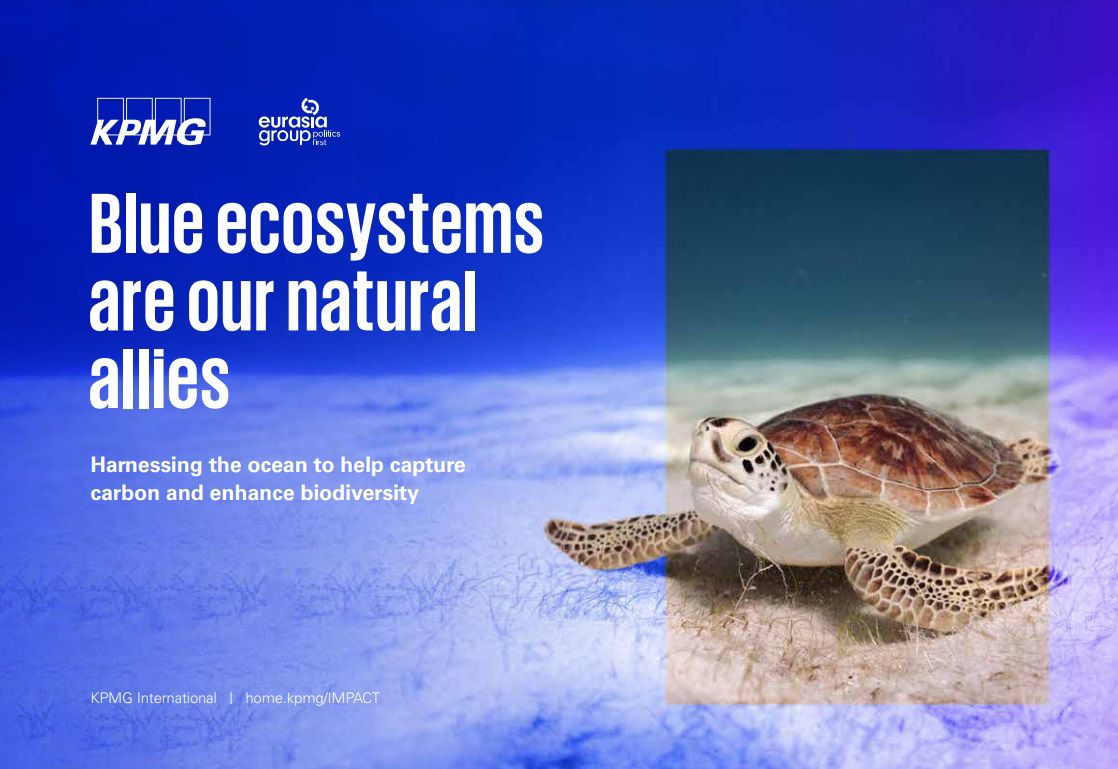Since the Industrial Revolution,1 humans have emitted more than 2,000 gigatons of CO2 (GtCO2) into the atmosphere. Even the most ambitious projections acknowledge that we’ll fall well short of the Paris Agreement target of 1.5 degrees global warming by 2050.2 Simply reducing emissions won’t be enough — scientists predict that up to 10 GtC will need to be removed annually from the atmosphere by 2050, with increased removal capacity up to 20 GtC per year by 2100.3
The ocean is a vital ally in this existential venture. Blue carbon ecosystems (BCEs) — which include mangroves, tidal and salt marshes, seagrasses as well as open ocean food webs and nutrient cycles — have enormous capacity to store carbon within the plants, animal biomass and in the sediments below for long periods of time. Estimates suggest that investments in BCEs could capture and reduce emissions of nearly 4 GtC per annum in 2030 and by more than 11 GtC per annum in 2050.4 Conversely, when disrupted, BCEs could potentially also release carbon, which makes it even more important to conserve and restore these vital resources to aid the fight against climate change and biodiversity loss.
When compared to technological carbon removal options such as direct air capture, geological capture and biochar production, ‘natural climate solutions’ like BCEs are potentially more cost-effective and scalable. BCEs provide win–win solutions — sequestering carbon while improving ocean health and biodiversity as well as the livelihood of millions of people in coastal communities. BCEs are widespread, highly productive coastal habitats that host diverse ecological communities, providing food and coastal protection against erosion and sea-level rise. They also play a critical role in food supply, not just for coastal communities but also for almost all global countries as well. However, BCEs have not yet been deployed at a large scale and face barriers to widespread adoption.
In this report we will:
- examine some of the science behind ocean systems and BCEs
- look at the different ways they can capture carbon while promoting ecosystem resilience and regeneration
- discuss how governments, businesses and other stakeholders can drive investment in the sector by integrating BCEs into carbon standards, influencing public policy and funding projects through the private sector.
The case for blue carbon ecosystems
If we’re to meet climate and societal goals, we need solutions that not only reduce emissions, but also promote the biodiversity and health of natural systems that support societies and livelihoods. There’s a growing recognition of the role of natural climate solutions (NCSs) in tackling these challenges, such as through ecosystem management and reforestation.5
KPMG’s Blue economy report suggests that carbon removal projects could capture an outsised share of the growing demand for offsets. Carbon offsets have been largely focused on terrestrial sources and through carbon capture, utilisation and storage (CCU) technology advances, with 2021 a bumper year for new CCUs.6
However, the finite supply of land-based offset sources is likely to push up prices and benefit larger and more expensive carbon removal projects — particularly in the medium term. The world needs to remove an estimated 10 GtC per year by 2050 and 20 GtCO2 per year by 2100, but tightening standards and higher environmental integrity have created uncertainty over the supply of the carbon credits that fund many carbon capture projects.

There has been increased appreciation of the potential value of BCEs as benefits, which include healthy seafood stocks, flooding and erosion protection, freshwater access as well as the regulation of global temperatures, are becoming an increasing necessity. Furthermore, BCEs are endemic to both temperate and tropical regions and can have wider impacts to countries with and without a coastline.
To give you an idea of the enormous potential oceanbased carbon removal strategies have, research has shown that the ocean contains an estimated 39,000 Gt of carbon, equivalent to 50 times the amount in the atmosphere, and is estimated to have captured 38 percent of emissions caused by humans over the past two centuries.9 And, with its area and depth, it has a virtually limitless capacity to store carbon, especially when we look at the bottom of the ocean and the potential for natural deep sea carbon storage.10
This means the combination of terrestrial challenges, like limited and costly carbon capture and rising demand for wider environmental benefits, makes BCEs an especially appealing solution for investors.
The science behind key ocean processes
We now know the ocean is vital to our well-being and livelihood, but how does it make itself so valuable to us? Well, firstly, ocean circulations are influenced globally by polar processes and redistribute carbon across long distances and great depths. The ocean moves heat and carbon from warm, surface waters toward cool waters in its deeper layers. Winds bring cold water up from deep layers in some regions, allowing carbon exchange between the deep ocean and the atmosphere and powering biological production. This enables the ocean to regulate the climate, provide energy, capture carbon, and disseminates the essential elements of living matter.
If we focus on carbon capture specifically, temperate and tropical coastal ecosystems are significant net carbon sinks — i.e natural reservoirs that absorb and store the atmosphere’s CO2.11 In the open ocean, carbon sink forms from two compartments:
1) Physical and
2) Biological.
Assessing the readiness of BCE’s
The ocean offers many opportunities to address climate change, with varying levels of investment and innovation maturity.
Due to cost and feasibility, no single BCE solution exists that will remove sufficient carbon to meet science-based targets. BCE solutions should consider cost effectiveness, scalability, regulatory acceptance, and wider ESG benefits. This section showcases the main BCE approaches ranked by an indicative maturity in terms of current adoption and implementation-readiness. Ecosystem benefits are highlighted to show that carbon sequestration is not the only driver for investing in each BCE solution.
1. Ocean vegetation restoration
Ecosystem Benefits: Boosts fish stocks and food security, biodiversity protection, water filtration, and coastal protection; and enhances local and open ocean fishermen’s livelihoods.
Investment Readiness: High — multiple projects are proven successes and are operating in the market currently.
2. Ocean alkalinity enhancement
Ecosystem Benefits: Provides stability to currents and food web dynamics; promotes coral reef regeneration and protection.
Investment Readiness: Medium — currently, a few projects are ready for implementation; however, most are in impact refinement and approval states.22
3. Ocean fertilisation
Ecosystem Benefits: Provides stability to the foundational structures of ocean food web and dynamics.
Investment Readiness: Low — Most projects are in either testing or refinement stages.28
4. CO2 injections
Ecosystem Benefits: Prevention of CO2 entering oceans, countering temperature rises and ocean acidification.
Investment Readiness: Low — most projects are in assessment and testing stages.35
Three ways to drive greater BCE adoption in climate plans
Although there are several barriers that stand in the way of large-scale BCE adoption, the necessity of finding viable ecosystem solutions should be a conduit to removing these barriers. Below are three ways in which companies and governments can increase adoption of BCEs and stimulate global interest and adoption.
- Include BCEs as part of your organisation’s climate strategy
- Integrating BCEs in verified offset markets will allow for investors and adopters to gain a reliable financial return alongside ecosystem benefits
- Integrate BCEs into countries' NDCs pledges

The blue economy is an untapped opportunity for progressing climate and nature positive plans
BCEs are an essential part of the global drive to counter climate change, protect biodiversity and enhance livelihoods by capturing carbon and keeping ocean and freshwater systems healthy and productive to help ensure sustainable future. BCEs provide a clear win–win situation for organisations looking to offset their carbon emissions while also investing in a nature positive strategy.
But there’s an urgent need to increase awareness by building compelling scientific and commercial arguments for faster, wide-scale adoption. At a global level, governments and other stakeholders can push the agenda of the UN Decade of Ocean Science (2021–2030) and UN Decade on Ecosystem Restoration (2021–2030).52
Both larger, developed countries, as well as the developing world, can address climate change through coastal restoration or habitat creation, to capture carbon and protect against rising sea levels. The main beneficiaries would be those with extensive, carbon-rich BCEs that have already experienced high rates of loss.53
Companies can seek to include BCE projects as part of their carbon offset program to meet decarbonisation targets, leading by example, protecting oceans, biodiversity and reducing carbon. Such behavior demonstrates the win–win of blue carbon offset projects.
In building a strong case for BCE carbon capture, however, a lack of existing data to assess either the extent of BCEs or carbon stocks, particularly in the case of tidal marsh and seagrass ecosystems remains a barrier. Therefore, initiating, measuring and reporting BCE projects will create a global library of success, unlocking much-needed capital to help drive a net-zero future.
Get in touch
Connect with us
- Find office locations kpmg.findOfficeLocations
- kpmg.emailUs
- Social media @ KPMG kpmg.socialMedia
1IPCC, 2018: Global Warming of 1.5°C. An IPCC Special Report on the impacts of global warming of 1.5°C above pre-industrial levels and related global greenhouse gas emission pathways, in the context of strengthening the global response to the threat of climate change, sustainable development, and efforts to eradicate poverty [Masson- Delmotte, V., P. Zhai, H.-O. Pörtner, D. Roberts, J. Skea, P.R. Shukla, A. Pirani, W. Moufouma-Okia, C. Péan, R. Pidcock, S. Connors, J.B.R. Matthews, Y. Chen, X. Zhou, M.I. Gomis, E. Lonnoy, T. Maycock, M. Tignor, and T. Waterfield (eds.)]. In Press.
2 State of Climate Action 2021: Systems Transformations Required to Limit Global Warming to 1.5°C , World Resources Institute, 28 October 2021
3 Carbon removal, Assessing carbon removal pathways, their potential, barriers and policy options to accelerate development as part of a suite of climate actions, World Resources Institute
4 Hoegh-Guldberg. O., et al. 2019. ‘‘The Ocean as a Solution to Climate Change: Five Opportunities for Action.’’ Report. Washington, DC: World Resources Institute.
5 Macreadie, P.I., Costa, M.D.P., Atwood, T.B. et al. Blue carbon as a natural climate solution.
6 Carbon capture in 2021: Off and running or another false start?, IEA, 24 November 2021
9 Ocean storage, Chapter 12, Science direct, page 1
10 Ocean storage, Chapter 6, IPCC Special Report on Carbon dioxide Capture and Storage, page 3
11 What is Blue Carbon? — The Blue Carbon initiative
22 Removing carbon dioxide through ocean alkalinity enhancement: legal challenges and opportunities, Columbia Law School, August 2021
28 Ocean Fertilization: Science, Policy, and Commerce, The Oceanography- Society, 2 October 2015
35 IPCC Special Report on Carbon dioxide Capture and Storage, Chapter 6, Ocean Storage, 2018
52 Waltham, N.J. et al. UN Decade on Ecosystem Restoration 2021–2030 — what chance for success in restoring coastal ecosystems? Front. Mar. Sci. 7, 71 (2020).
53 Hamilton, S.E. and Friess, D.A. Global carbon stocks and potential emissions due to mangrove deforestation from 2000 to 2012. Nat. Clim. Chang. 8, 240–244 (2018).



